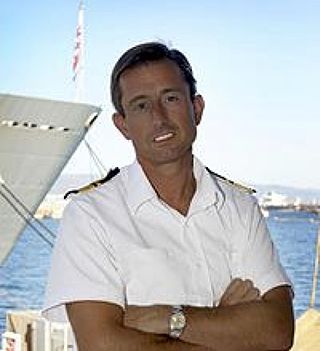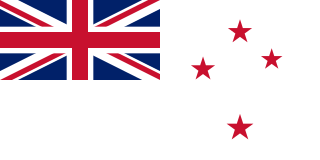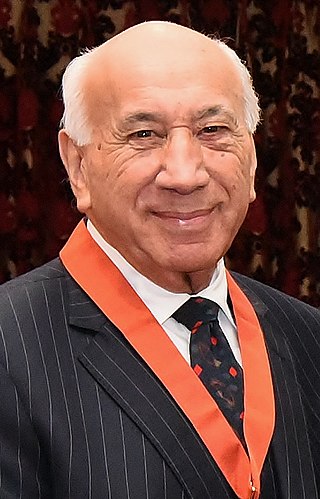
The Royal New Zealand Navy is the maritime arm of the New Zealand Defence Force. The fleet currently consists of nine ships. The Navy had its origins in the Naval Defence Act 1913, and the subsequent purchase of the cruiser HMS Philomel, which by 1921 had been moored in Auckland as a training ship. A slow buildup occurred during the interwar period, and then perhaps the infant Navy's most notable event occurred when HMS Achilles fought alongside two other Royal Navy cruisers at the Battle of the River Plate against the German ship, Graf Spee, in December 1939.

Admiral Sir William Edward Parry, was an officer of the Royal Navy.

HMNZS Waikato (F55) was a Leander Batch 2TA frigate of the Royal New Zealand Navy (RNZN). She was one of two Leanders built for the RNZN, the other being the Batch 3 HMNZS Canterbury. These two New Zealand ships relieved British ships of the Armilla patrol during the Falklands conflict, freeing British ships for deployment.

Vice Admiral Sir Peter Phipps, was a senior officer of the Royal New Zealand Navy (RNZN) from the 1940s to 1960s.
Thomas Henry Logan was a New Zealand water polo player, swimmer, surf lifesaver, dentist and naval officer.
Admiral Sir Geoffrey John Audley Miles, KCB, KCSI was a senior Royal Navy admiral who served as Deputy Naval Commander, South East Asia Command under Lord Mountbatten during the Second World War, as the Senior British Representative on the Tripartite Naval Commission and as the last Commander-in-Chief, Indian Navy of the unified Royal Indian Navy.

Rear Admiral Matthew John Parr, is a retired Royal Navy officer who has served as Commander Operations and Rear Admiral, Submarines and is currently an Inspector of Constabulary and Fire & Rescue Services.

Rear Admiral David Ian Ledson, is a retired senior officer of the Royal New Zealand Navy and former Chief of Navy (2004–09). He is the Chairman of the Board of Maritime New Zealand, and was named a Companion of the Royal Society of New Zealand in 2009.
Rear Admiral Edward Courtney "Ted" Thorne, was a senior Royal New Zealand Navy officer. He rose to be Chief of Naval Staff and later served as the Commissioner of the New Zealand Fire Service.

Chief of Navy (CN) commands the Royal New Zealand Navy (RNZN) and is responsible to the Chief of Defence Force (CDF) for raising, training and sustaining those forces necessary to meet agreed government outputs. The CN acts as principal advisor to the CDF on Navy matters, and is the most senior appointment in the RNZN. The rank associated with the position is rear admiral, and CNs are generally appointed on a three-year term.
William James Lanyon Smith was a New Zealand naval officer. He served in the Royal New Zealand Naval Volunteer Reserve during World War II and was second-in-command of a midget submarine during an attack in Singapore codenamed Operation Struggle, for which he was appointed a Companion of the Distinguished Service Order.

Rear Admiral Jack Raymond Steer, is a retired Royal New Zealand Navy officer, who served as Chief of Navy from 2012 to 2015.
Vice Admiral Sir Maxwell Richmond was a New Zealand-born officer in the Royal Navy.

Sir Tīmoti Samuel Kāretu is a New Zealand academic of Māori language and performing arts. He served as the inaugural head of the Department of Māori at the University of Waikato, and rose to the rank of professor. He was the first Māori language commissioner, between 1987 and 1999, and then was executive director of Te Kohanga Reo National Trust from 1993 until 2003. In 2003, he was closely involved in the foundation of Te Panekiretanga o te Reo, the Institute of Excellence in Māori Language, and served as its executive director. He is fluent in Māori, English, French and German.

The 1953 Coronation Honours in New Zealand, celebrating the coronation of Elizabeth II, Queen of New Zealand, were appointments made by the Queen on the advice of the New Zealand government to various orders and honours to reward and highlight good works by New Zealanders. Also included were a number of special awards to New Zealand military personnel for operational service in Korea. The honours were announced on 1 June 1953.
The 1971 Queen's Birthday Honours in New Zealand, celebrating the official birthday of Elizabeth II, were appointments made by the Queen on the advice of the New Zealand government to various orders and honours to reward and highlight good works by New Zealanders. They were announced on 12 June 1971.
The 1987 New Year Honours in New Zealand were appointments by Elizabeth II on the advice of the New Zealand government to various orders and honours to reward and highlight good works by New Zealanders. The awards celebrated the passing of 1986 and the beginning of 1987, and were announced on 31 December 1986.

Vice Admiral Mark David Hammond, is a senior officer in the Royal Australian Navy (RAN), serving as the Chief of Navy since July 2022. He joined the RAN as an electronics technician in 1986 and, after being accepted for officer training, graduated from the Australian Defence Force Academy in 1990. Much of Hammond's career has been spent in the Submarine Service. He has served on operations in the Indo-Pacific, commanded the Collins-class submarineHMAS Farncomb, was Deputy Chief of Navy from 2018 to 2020, and served as Commander Australian Fleet from November 2020 to June 2022. He succeeded Vice Admiral Michael Noonan as Chief of Navy on 6 July 2022.
Rear Admiral Sadashiv Ganesh Karmarkar, was a flag officer in the Indian Navy. He was the first Indian officer to command a ship of the Royal Indian Navy. During World War II, he commanded the auxiliary patrol vessel HMIS Ratnagiri, for which he was awarded the Member of the Order of the British Empire (MBE). He later became the first Indian to command British officers, when he commanded the sloop HMIS Kistna. He last served as the Flag Officer Bombay, from 1960 to 1964, before retiring.
Rear Admiral Ian Alexander Hunter was an officer of the Royal New Zealand Navy, who served as Chief of Naval Staff from March 1991 to April 1994.











